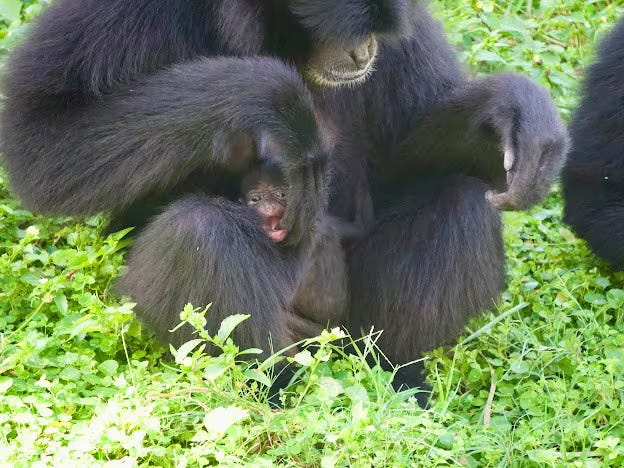Simian Stripling, Squeezin' and Swingin'
Tampa zoo welcomes a baby siamang gibbon
In the late hours of Sunday, October 27th, ZooTampa in Florida got themselves a new resident. The zoo’s mated pair of endangered simian gibbons, mother Hutan and father Sensei welcomed a new baby into the mix. The baby is doing well, spending her time clinging to her mom, nursing, resting, and bonding, while nearby big sister Kazuki (born at the zoo three years ago) and dad keep a watchful eye on their newest family member. The infant is not yet named and it will be a few weeks before the zoo can determine her gender.
Measuring in at about 3.3 feet tall and 30 pounds, siamangs are the largest members of the gibbon family, native to the forests of Indonesia, Malaysia and Thailand. They have sparse, thin coats when young, save a tuft of hair on the head. The babies are born with strong grips and they will cling to their mothers for three or four months for warmth, security and nursing. Siamangs generally live in family groups, with monogamous pairs mating for life (although there are some instances of polyandrous groups), and children staying with their parents until about six to eight years old. To defend their territories and strengthen family bonds, they start their day with group vocalizations, a unique call that lasts about 25 minutes. With mated pairs, this vocalization is known as “duetting,” which I think is marvelous. Newly formed mating pairs spend more time duetting than established couples; ah, those public displays of affection from young lovers, am I right?!
Built to navigate the forest canopies in which they live, siamangs have evolved to be great climbers and can swing from tree to tree with ease (a movement known as brachiation). Their locomotive skill comes from strong arms that are much longer than their bodies, with arm spans reaching up to five feet. Those lanky arms also help young siamangs hold on tight to their mothers, hugging closely while mom navigates her way though the heights. In her first year, Hutan’s baby will cling to her mom; then dad Sensi will take over parenting duties, just as siamangs do in the wild. Eventually the baby will follow in the footsteps of her big sister, swinging around in the zoo’s outdoor play structure and joining in with the family’s morning singing session.
Source for today’s hed gif comes from the WFLA News Channel 8 page on Facebook.
ZooTampa: “Endangered Siamang Gibbon Baby Born at ZooTampa,” 11/1/24




Ta, Martini. Didn't know this one.
Ah, I was wondering what that was. I thought it didn't look like a chimp or a gorilla but those were the only two black-furred primates I could think of offhand.